2018 TOYOTA TUNDRA fuel
[x] Cancel search: fuelPage 601 of 672

6019-1. Specifications
9
Vehicle specifications
Engine
Model1UR-FE, 3UR-FE, 3UR-FBE
Ty p e8-cylinder V-type, 4-cycle, gasoline
Bore and stroke
1UR-FE engine
3.70 3.27 in. (94.0 83.0 mm)
3UR-FE and 3UR-FBE engines
3.70 4.02 in. (94.0 102.0 mm)
Displacement
1UR-FE engine
281.2 cu.in. (4608 cm
3)
3UR-FE and 3UR-FBE engines
345.6 cu.in. (5663 cm
3)
Drive belt tensionAutomatic adjustment
Valve clearance
(engine cold)Automatic adjustment
Fuel
EngineModel1UR-FE and 3UR-FE
engines3UR-FBE engine
Ty p eGasoline engineFlex-fuel engine
Fuel typeUnleaded gasoline only
Unleaded gasoline,
E85, or a blend of the two fuels
Octane rating
(Unleaded gasoline)87 (Research Octane Number 91) or higher
Ethanol percentage
(E85)—85% or less
Fuel tank capacity
(Reference)
Standard fuel tank: 26.4 gal. (100.0 L, 22.0 Imp.gal.)
Large fuel tank: 38.0 gal. (144.0 L, 31.7 Imp.gal.)
Page 602 of 672
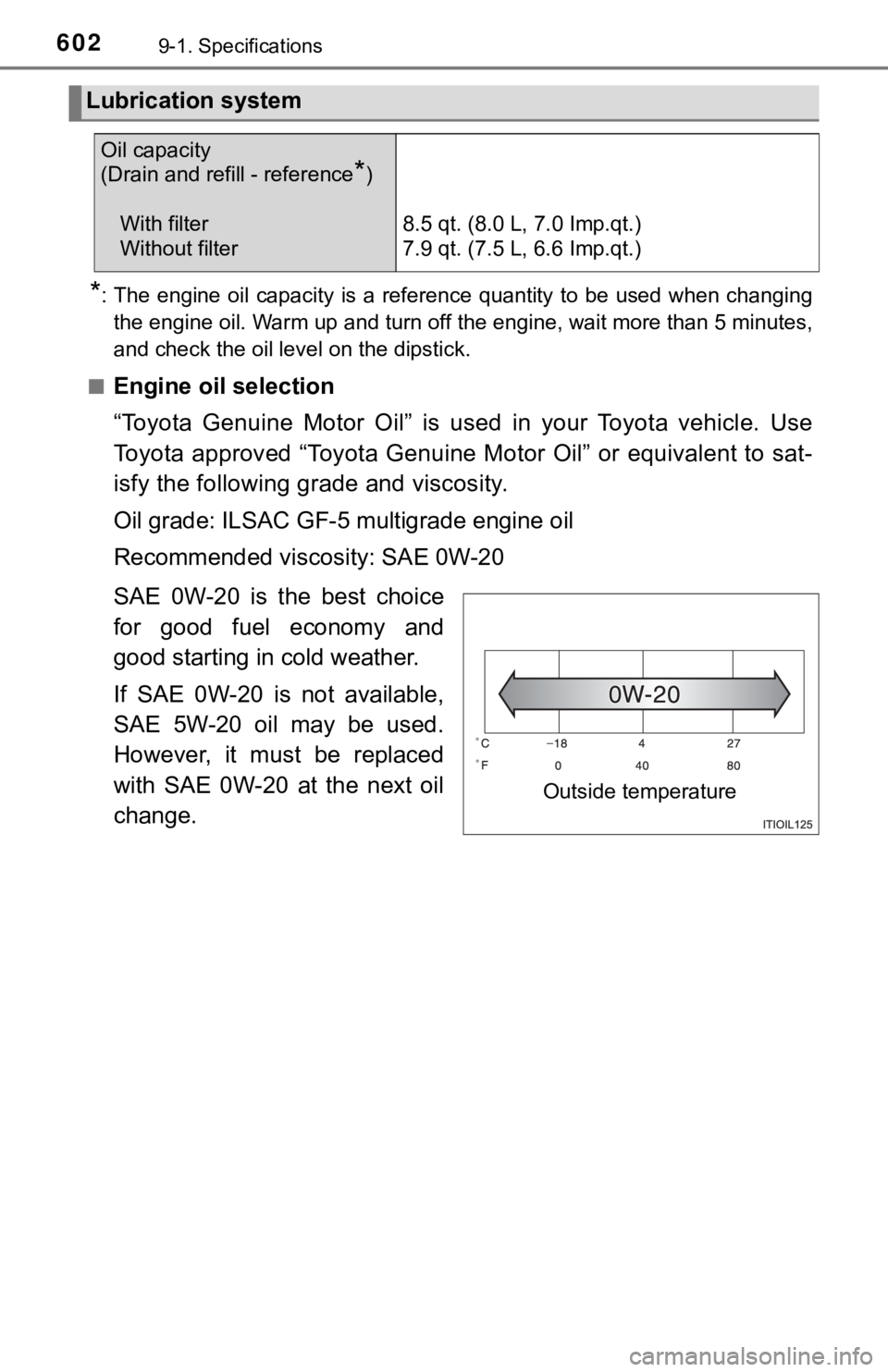
6029-1. Specifications
*: The engine oil capacity is a reference quantity to be used when changing
the engine oil. Warm up and turn off the engine, wait more than 5 minutes,
and check the oil level on the dipstick.
■
Engine oil selection
“Toyota Genuine Motor Oil” is us ed in your Toyota vehicle. Use
Toyota approved “Toyota Genuine Motor Oil” or equivalent to sat -
isfy the following grade and viscosity.
Oil grade: ILSAC GF-5 multigrade engine oil
Recommended viscosity: SAE 0W-20
SAE 0W-20 is the best choice
for good fuel economy and
good starting in cold weather.
If SAE 0W-20 is not available,
SAE 5W-20 oil may be used.
However, it must be replaced
with SAE 0W-20 at the next oil
change.
Lubrication system
Oil capacity
(Drain and refill - reference
*)
With filter
Without filter 8.5 qt. (8.0 L, 7.0 Imp.qt.)
7.9 qt. (7.5 L, 6.6 Imp.qt.)
Outside temperature
Page 610 of 672
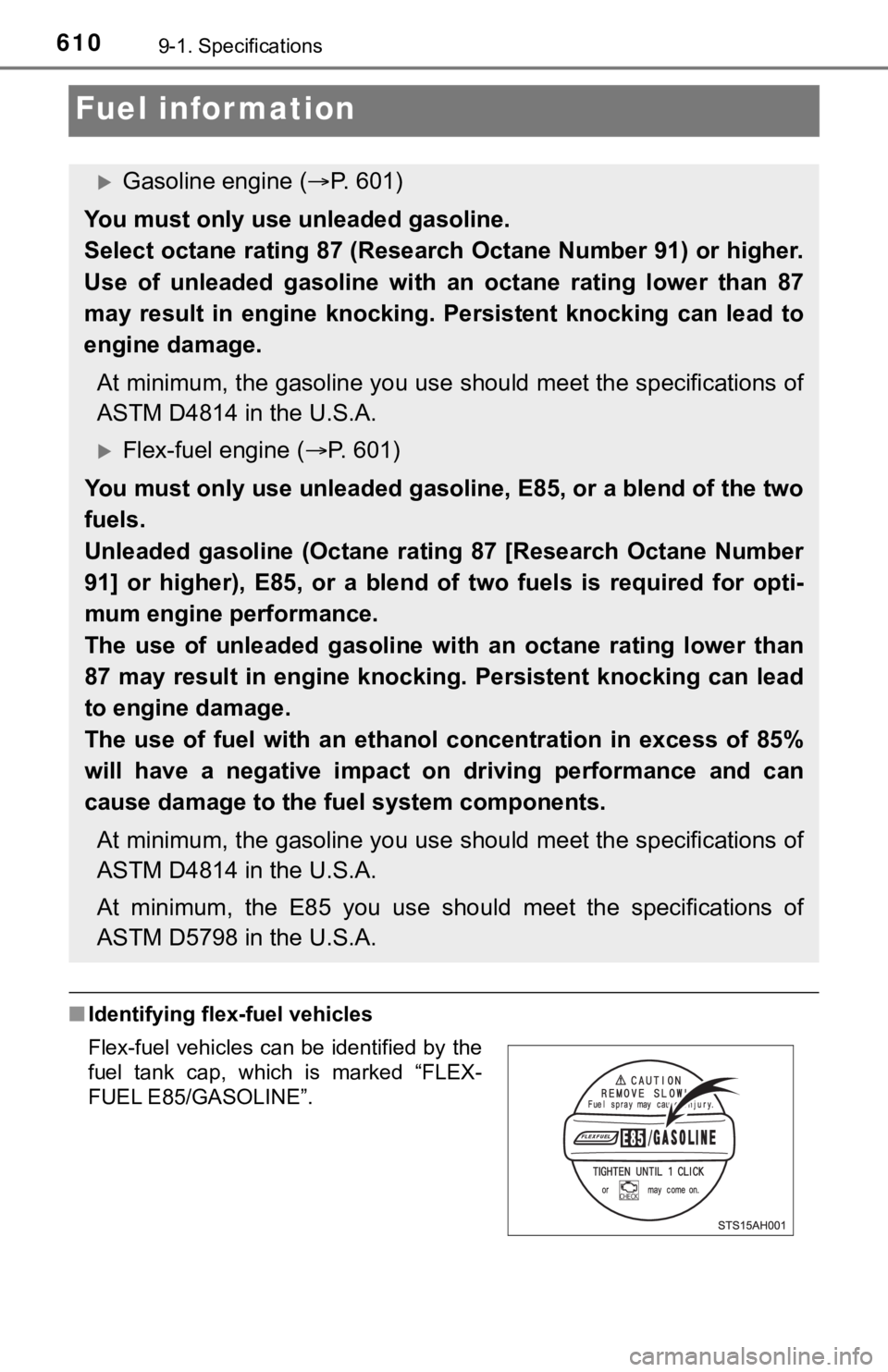
6109-1. Specifications
Fuel information
■Identifying flex-fuel vehicles
Gasoline engine ( P. 601)
You must only use unleaded gasoline.
Select octane rating 87 (Research Octane Number 91) or higher.
Use of unleaded gasoline with an octane rating lower than 87
may result in engine knocking. Persistent knocking can lead to
engine damage.
At minimum, the gasoline you use should meet the specifications of
ASTM D4814 in the U.S.A.
Flex-fuel engine ( P. 601)
You must only use unleaded gasoli ne, E85, or a blend of the two
fuels.
Unleaded gasoline (Octane rating 87 [Research Octane Number
91] or higher), E85, or a blend of two fuels is required for op ti-
mum engine performance.
The use of unleaded gasoline with an octane rating lower than
87 may result in engine knocking. Persistent knocking can lead
to engine damage.
The use of fuel with an ethanol concentration in excess of 85%
will have a negative impact on driving performance and can
cause damage to the fuel system components.
At minimum, the gasoline you use should meet the specifications of
ASTM D4814 in the U.S.A.
At minimum, the E85 you use should meet the specifications of
ASTM D5798 in the U.S.A.
Flex-fuel vehicles can be identified by the
fuel tank cap, which is marked “FLEX-
FUEL E85/GASOLINE”.
Page 611 of 672
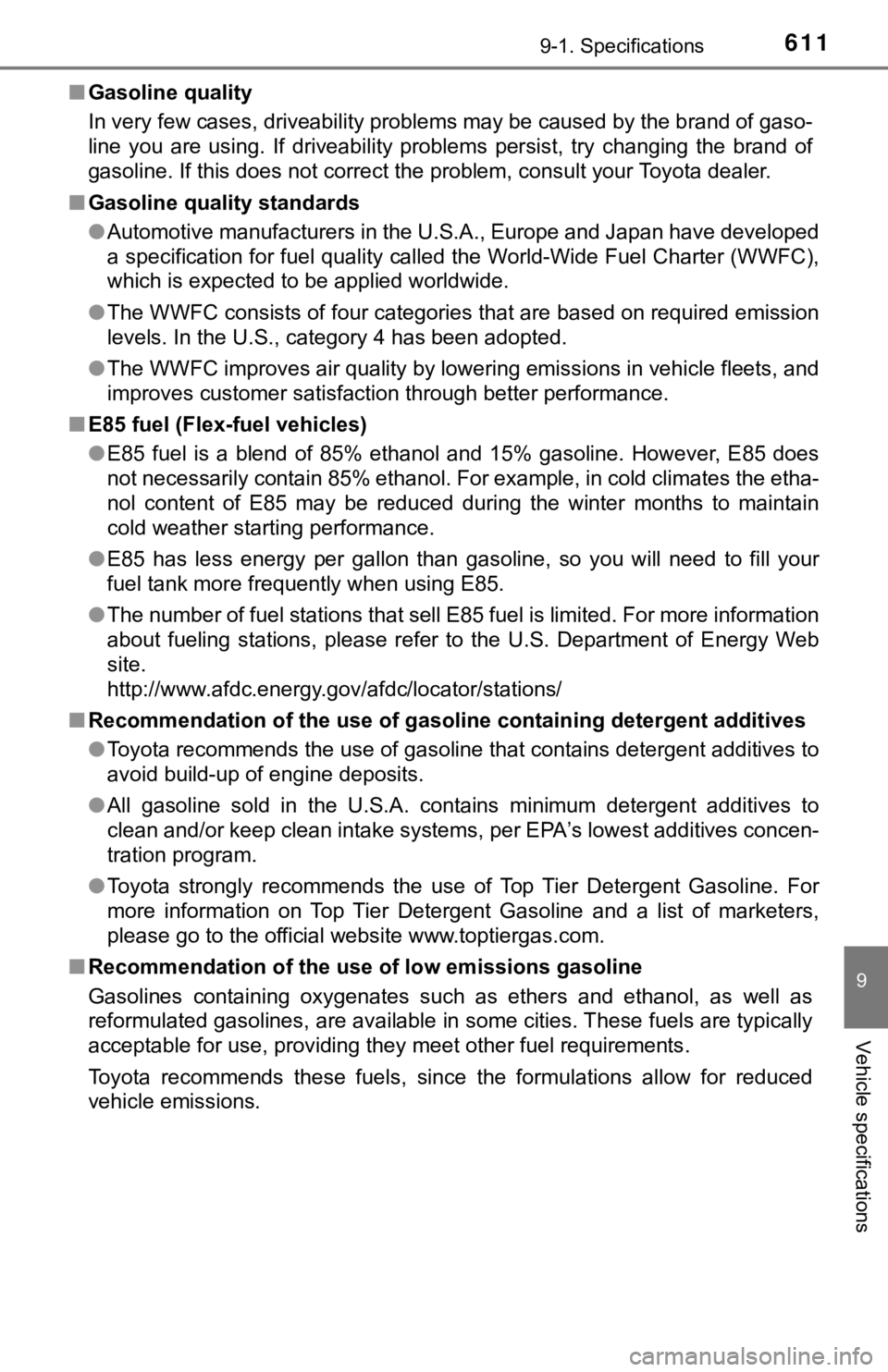
6119-1. Specifications
9
Vehicle specifications
■Gasoline quality
In very few cases, driveability problems may be caused by the b rand of gaso-
line you are using. If driveability problems persist, try changing the brand of
gasoline. If this does not correct the problem, consult your To yota dealer.
■ Gasoline quality standards
●Automotive manufacturers in the U.S.A., Europe and Japan have developed
a specification for fuel quality called the World-Wide Fuel Cha rter (WWFC),
which is expected to be applied worldwide.
● The WWFC consists of four categories that are based on required emission
levels. In the U.S., category 4 has been adopted.
● The WWFC improves air quality by lowering emissions in vehicle fleets, and
improves customer satisfaction through better performance.
■ E85 fuel (Flex-fuel vehicles)
●E85 fuel is a blend of 85% ethanol and 15% gasoline. However, E 85 does
not necessarily contain 85% ethanol. For example, in cold clima tes the etha-
nol content of E85 may be reduced during the winter months to m aintain
cold weather starting performance.
● E85 has less energy per gallon than gasoline, so you will need to fill your
fuel tank more frequently when using E85.
● The number of fuel stations that sell E85 fuel is limited. For more information
about fueling stations, please refer to the U.S. Department of Energy Web
site.
http://www.afdc.energy.gov/afdc/locator/stations/
■ Recommendation of the use of gaso line containing detergent additives
● Toyota recommends the use of gasoline that contains detergent a dditives to
avoid build-up of engine deposits.
● All gasoline sold in the U.S.A. contains minimum detergent addi tives to
clean and/or keep clean intake systems, per EPA’s lowest additi ves concen-
tration program.
● Toyota strongly recommends the use of Top Tier Detergent Gasoli ne. For
more information on Top Tier Detergent Gasoline and a list of m arketers,
please go to the official website www.toptiergas.com.
■ Recommendation of the use of low emissions gasoline
Gasolines containing oxygenates such as ethers and ethanol, as well as
reformulated gasolines, are available in some cities. These fue ls are typically
acceptable for use, providing they meet other fuel requirements .
Toyota recommends these fuels, since the formulations allow for reduced
vehicle emissions.
Page 612 of 672
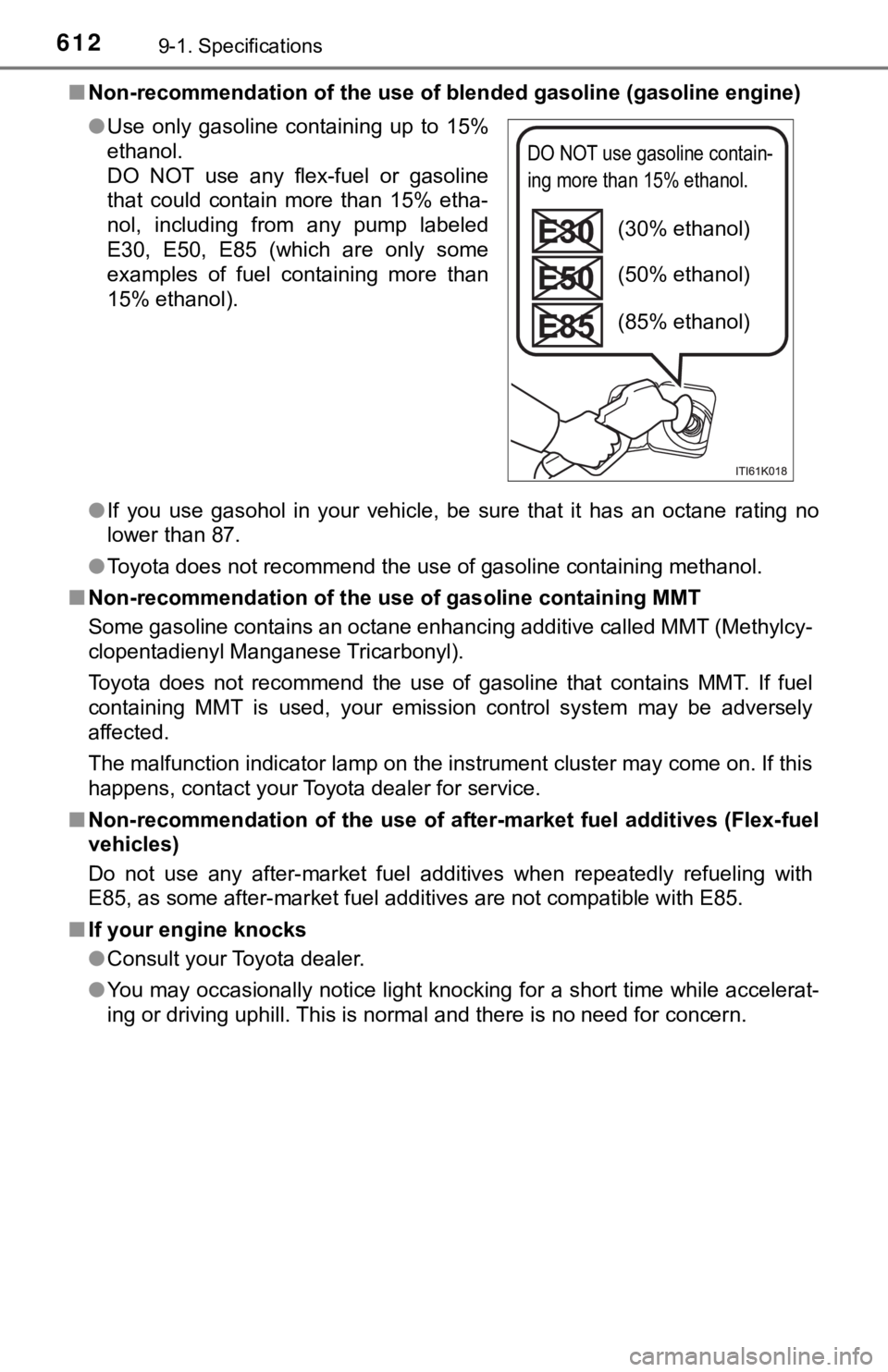
6129-1. Specifications
■Non-recommendation of the use of blended gasoline (gasoline engine)
● If you use gasohol in your vehicle, be sure that it has an octa ne rating no
lower than 87.
● Toyota does not recommend the use of gasoline containing methan ol.
■ Non-recommendation of the use of gasoline containing MMT
Some gasoline contains an octane enhancing additive called MMT (Methylcy-
clopentadienyl Manganese Tricarbonyl).
Toyota does not recommend the use of gasoline that contains MMT. If fuel
containing MMT is used, your emission control system may be adv ersely
affected.
The malfunction indicator lamp on the instrument cluster may come on. If this
happens, contact your Toyota dealer for service.
■ Non-recommendation of the use of after-market fuel additives (Flex-fuel
vehicles)
Do not use any after-market fuel additives when repeatedly refu eling with
E85, as some after-market fuel additives are not compatible wit h E85.
■ If your engine knocks
●Consult your Toyota dealer.
● You may occasionally notice light knocking for a short time whi le accelerat-
ing or driving uphill. This is normal and there is no need for concern.
●
Use only gasoline containing up to 15%
ethanol.
DO NOT use any flex-fuel or gasoline
that could contain more than 15% etha-
nol, including from any pump labeled
E30, E50, E85 (which are only some
examples of fuel containing more than
15% ethanol).
DO NOT use gasoline contain-
ing more than 15% ethanol.
(30% ethanol)
(50% ethanol)
(85% ethanol)
Page 613 of 672
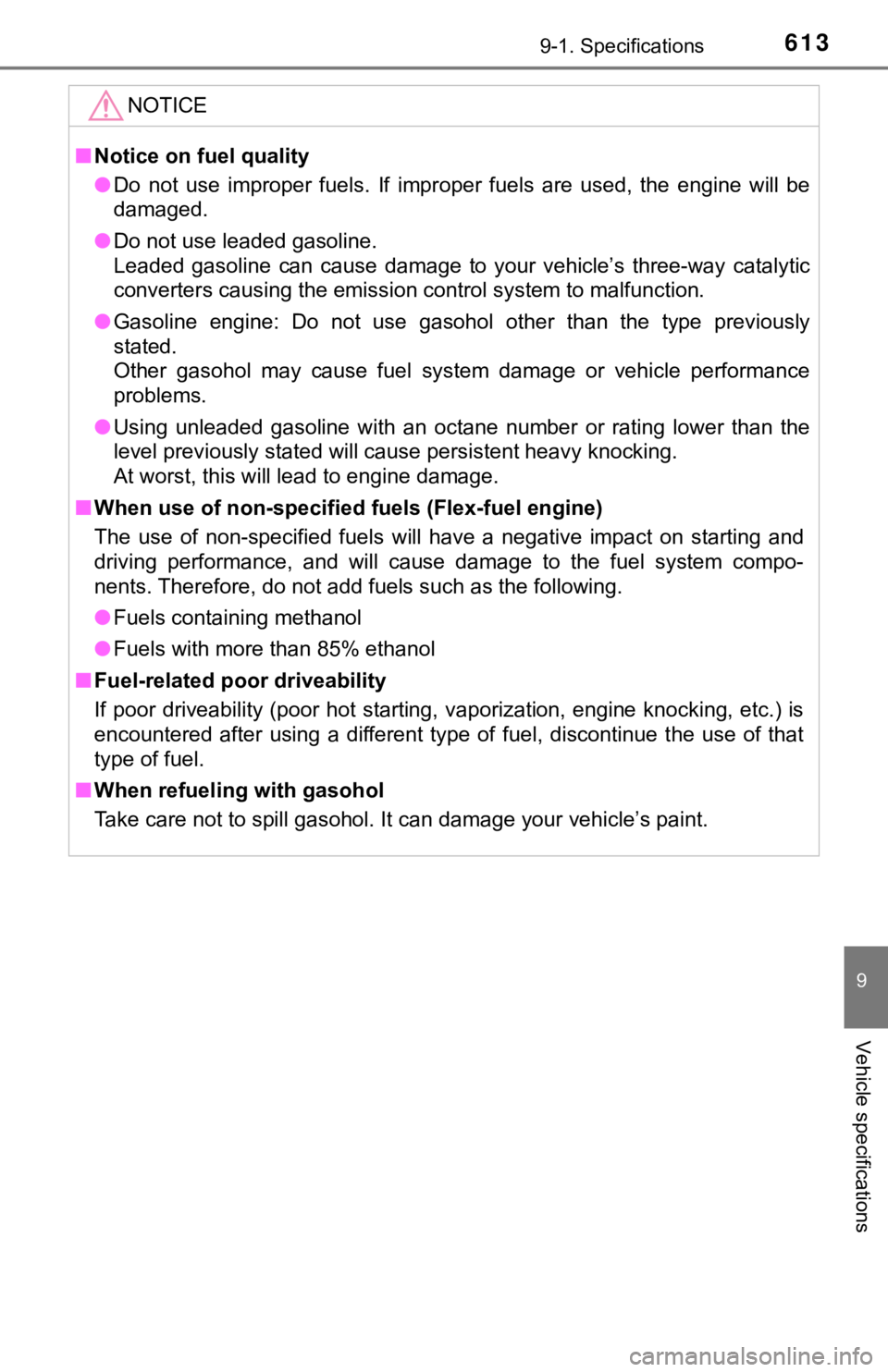
6139-1. Specifications
9
Vehicle specifications
NOTICE
■Notice on fuel quality
● Do not use improper fuels. If improper fuels are used, the engi ne will be
damaged.
● Do not use leaded gasoline.
Leaded gasoline can cause damage to your vehicle’s three-way ca talytic
converters causing the emission control system to malfunction.
● Gasoline engine: Do not use gasohol other than the type previou sly
stated.
Other gasohol may cause fuel system damage or vehicle performan ce
problems.
● Using unleaded gasoline with an octane number or rating lower than the
level previously stated will cause persistent heavy knocking.
At worst, this will lead to engine damage.
■ When use of non-specified fuels (Flex-fuel engine)
The use of non-specified fuels will have a negative impact on s tarting and
driving performance, and will cause damage to the fuel system c ompo-
nents. Therefore, do not add fuels such as the following.
● Fuels containing methanol
● Fuels with more than 85% ethanol
■ Fuel-related poor driveability
If poor driveability (poor hot starting, vaporization, engine k nocking, etc.) is
encountered after using a different type of fuel, discontinue the use of that
type of fuel.
■ When refueling with gasohol
Take care not to spill gasohol. It can damage your vehicle’s paint.
Page 619 of 672
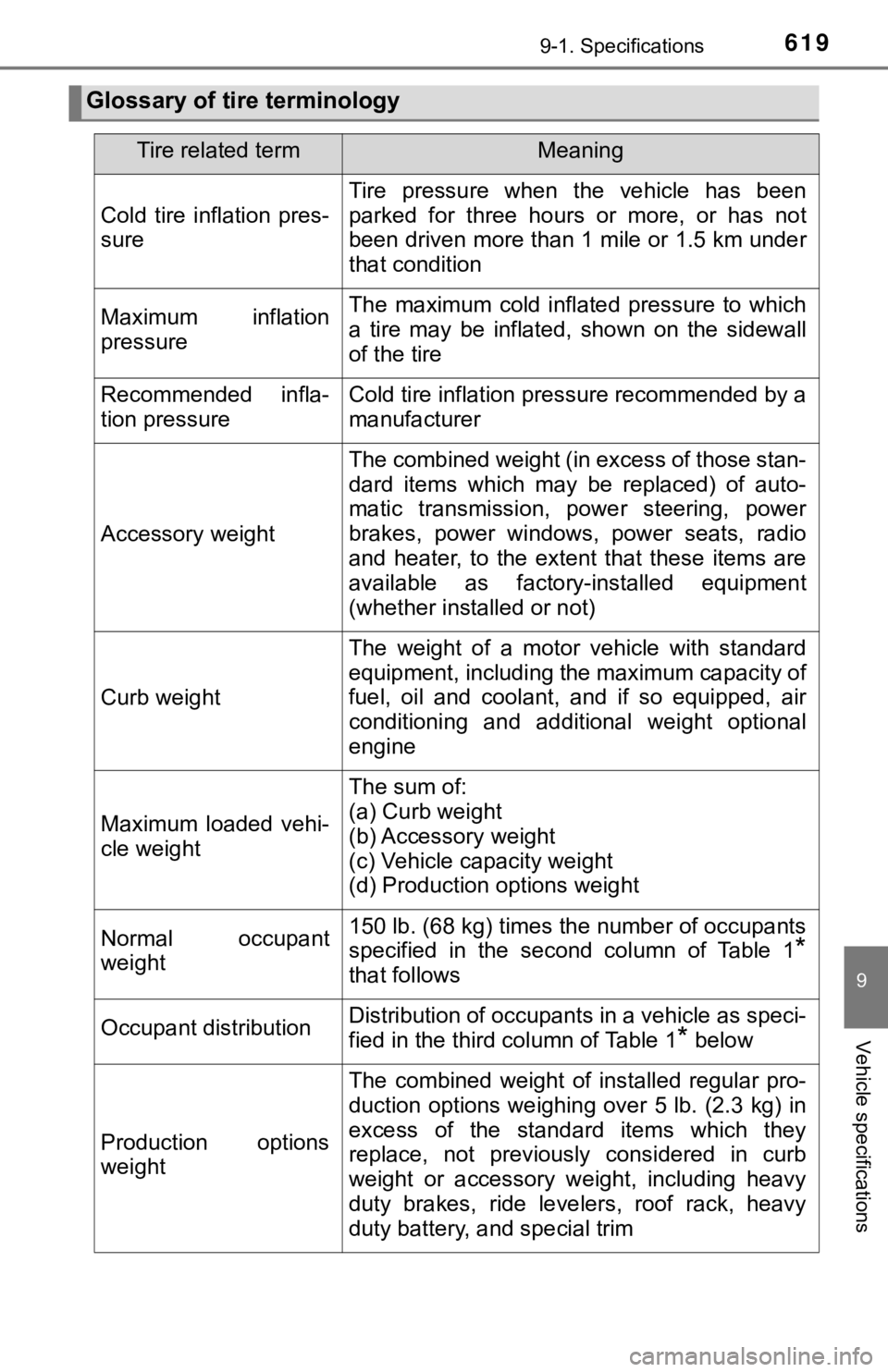
6199-1. Specifications
9
Vehicle specifications
Glossary of tire terminology
Tire related termMeaning
Cold tire inflation pres-
sure
Tire pressure when the vehicle has been
parked for three hours or more, or has not
been driven more than 1 mile or 1.5 km under
that condition
Maximum inflation
pressureThe maximum cold inflated pressure to which
a tire may be inflated, shown on the sidewall
of the tire
Recommended infla-
tion pressureCold tire inflation pressure recommended by a
manufacturer
Accessory weight
The combined weight (in excess of those stan-
dard items which may be replaced) of auto-
matic transmission, power steering, power
brakes, power windows, power seats, radio
and heater, to the extent that these items are
available as factory-installed equipment
(whether installed or not)
Curb weight
The weight of a motor vehicle with standard
equipment, including the maximum capacity of
fuel, oil and coolant, and if so equipped, air
conditioning and additional weight optional
engine
Maximum loaded vehi-
cle weight
The sum of:
(a) Curb weight
(b) Accessory weight
(c) Vehicle capacity weight
(d) Production options weight
Normal occupant
weight150 lb. (68 kg) times the number of occupants
specified in the second column of Table 1
*
that follows
Occupant distributionDistribution of occupants in a vehicle as speci-
fied in the third column of Table 1
* below
Production options
weight
The combined weight of installed regular pro-
duction options weighing over 5 lb. (2.3 kg) in
excess of the standard items which they
replace, not previously considered in curb
weight or accessory weight, including heavy
duty brakes, ride levelers, roof rack, heavy
duty battery, and special trim
Page 626 of 672
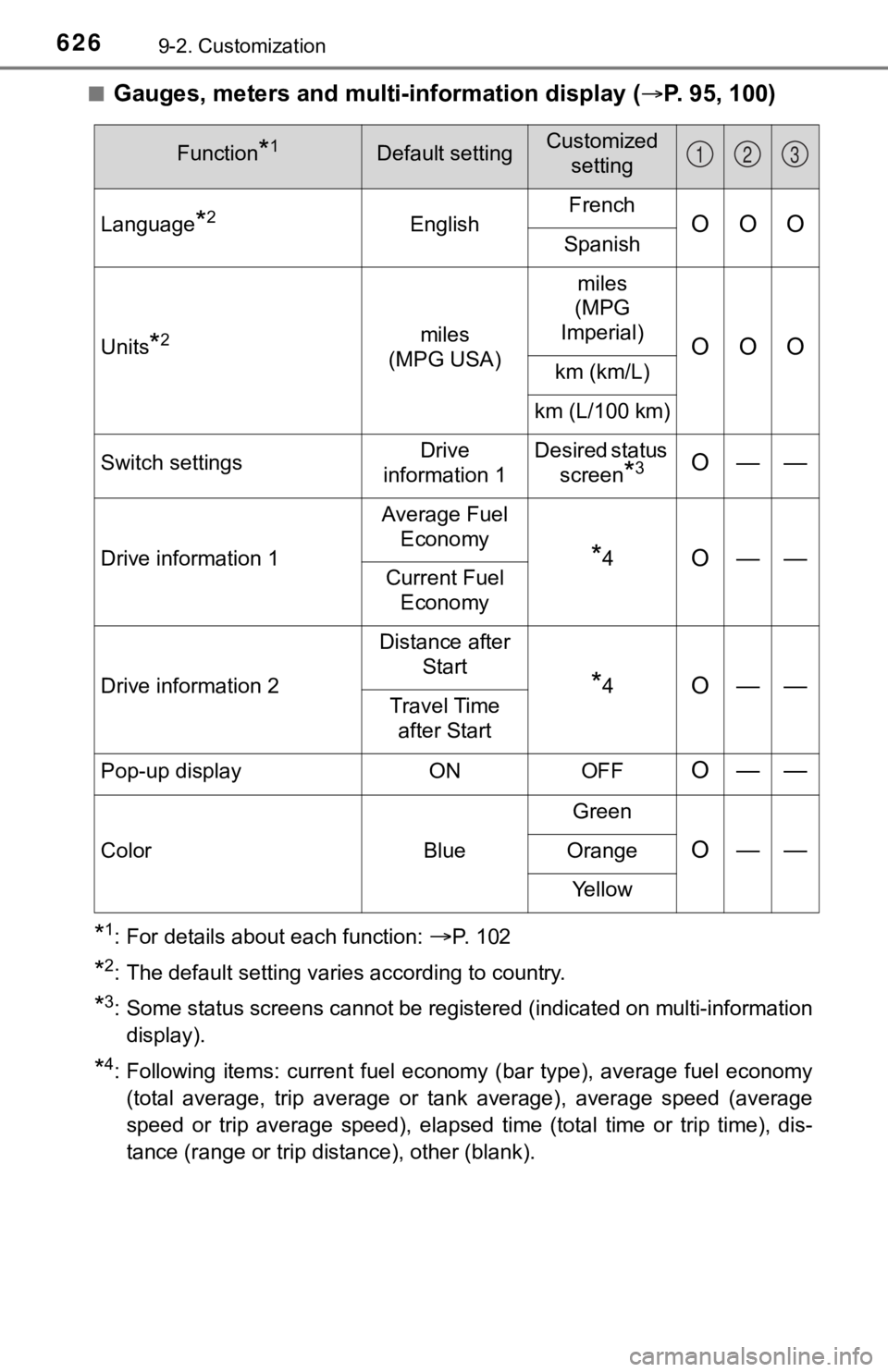
6269-2. Customization
■Gauges, meters and multi-information display (P. 95, 100)
*1: For details about each function: P. 102
*2: The default setting varies according to country.
*3: Some status screens cannot be registered (indicated on multi-i nformation
display).
*4: Following items: current fuel e conomy (bar type), average fuel economy
(total average, trip average or tank average), average speed (a verage
speed or trip average speed), elapsed time (total time or trip time), dis-
tance (range or trip distance), other (blank).
Function*1Default settingCustomized setting
Language*2English FrenchOOOSpanish
Units
*2miles
(MPG USA) miles
(MPG
Imperial)OOO
km (km/L)
km (L/100 km)
Switch settings Drive
information 1 Desired status
screen
*3O——
Drive information 1 Average Fuel
Economy*4O——Current Fuel Economy
Drive information 2 Distance after
Start
*4O——Travel Time after Start
Pop-up display ON OFF
O——
Color BlueGreenO——Orange
Ye l l o w
123